Using YouTube as a Path to Becoming a Full-Time Musician

So you’re a talented saxophone player who’s not quite making ends meet…
No, this isn’t the beginning of a cheesy commercial, please hear me out. :)
Today I’m going to share with you an alternative way to make a living as a saxophonist.
As the post goes on I’ll show you the kind of money that can be made, some musicians already following this path successfully, and give you tips on how you can get started yourself.
Please read in full to get the complete strategy; if you implement what you learn, this could over time become your full-time career.
The Strategy
The strategy at its core is simple, and one that doesn’t sound anything special:
Consistently put entertaining sax related videos on Youtube over time.
A bit of an anti-climax, right?
The thing is, the above statement doesn’t do the strategy justice.
When I say ‘entertaining videos’, I don’t mean ones of you simply playing the saxophone.
Or even performing a live show you did.
No, you want these videos to be a lot more Youtube friendly!
You see, Youtube rewards videos who make people laugh, makes them cry, or just makes them think ‘wow’.
When you stir a strong emotion, people will watch your videos longer.
If YouTube sees your videos are being watched longer than other similar uploads, they’ll push your videos more.
Youtube gets a highly engaged website visitor and you get more views; it’s win win!
The problem is, performing music in a traditional manner often doesn’t spark those kinds of emotions, unless it’s from an already popular act.
Which means it’s very hard for new saxophonists to get their video pushed via the Youtube algorithm.
And that’s where this strategy comes in.
Instead of loading up your camera and recording a cover of your favorite song, you need something called a ‘Music Tag-On’.
In short, a Music Tag-On is a hobby, interest or passion you ‘Tag-On’ to a percentage of videos you do on Youtube – or even just Tag-On to your branding.
Why This Works Well
I know it can sound a bit confusing at first, but we’ll look at real examples in a bit.
First though, I want to explain why this works so well.
First of all, when you combine your sax playing genius with another interest, you really become something unique.
Something people most likely haven’t seen before.
Even if you choose a combination people have seen before, there’s likely not many people who do something similar.
And it’s much better to compete with one other saxophonist that’s doing something similar to you, rather than compete with all the sax players in the world!
Next, when done right, your videos have a much higher chance of going viral than they would if you made regular performance videos.
There are a few reasons for this, namely:
- Longer watch time. As you’ll be doing things which likely aren’t already on Youtube, people in general will be more interested. Nothing kills view time like viewers feeling they’ve seen it all before within the first 10 seconds of your video. More watch time = more promotion from Youtube.
- The ‘stand out’ factor. At the time of writing this, there are next to no saxophonists using this strategy – or at least not that I’ve seen. But even for guitarists, who alongside producers are among those who use this strategy the most, there still aren’t that many people who have caught on to this opportunity. I don’t see this changing any time soon; most people are fully focused on a more traditional music career, so this gives you the chance to stand out.
- Cheaper marketing. If you want to speed up your ‘road to success’, you can always throw in advertising dollars once you’re seeing some success. At this stage it’ll be a lot cheaper to market yourself as more people you get in front of will check out what you’re doing – providing you’ve got good quality videos of course. On the other hand, marketing your latest instrumental to people who have heard many similar things before; it can get quite expensive.
Which Musicians Are Already Doing This? Let’s Look At Their Earnings
While as mentioned there aren’t many saxophonists already doing this, I’ve a long list of other musicians who are.
Using these 3 examples I’m about to share, you can get an idea of how this works so you can do something similar yourself.
I encourage you to go through their channels and look at the kind of videos they make, thinking about why their most popular videos have taken off.
Notes About Earnings
A quick note about how I work out the earnings; it’s widely assumed that you can make
$2 per 1000 Youtube views via ads, and around
$4 per stream or $7 per 1000 monthly listeners on Spotify.
Note: ‘streams’ and ‘monthly listeners’
are different; as we only get access to monthly listener data, I’ll use that $7 per 1000 monthly listeners number.
You can make a lot more or a lot less depending on a number of factors, but we’ll keep things simple with these base numbers.
You can adjust up or down as you see fit.
Secondly, of course, all these numbers are guesstimate.
The musicians I mention may earn a lot more or a lot less, I’m not their accountant so have no way of knowing.
All numbers are guesstimated for entertainment and education purposes only.
Musician: Jared Dines
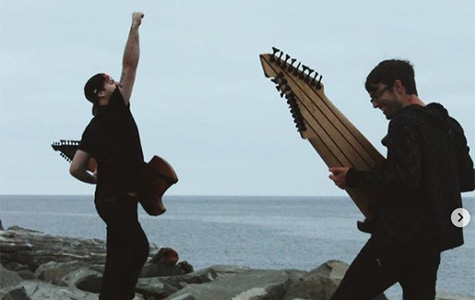
Music Tag-On: “Comedy/Music/Vlogs. Vocalist/Guitarist/Drummer. All things Metal/Metalcore.”
30 day views: 7,900,642.
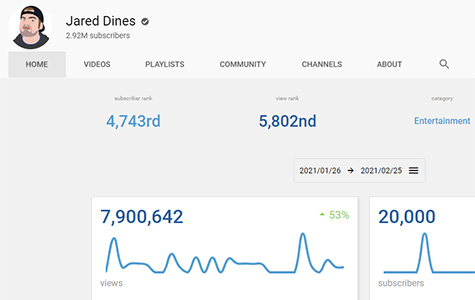
Guesstimated
30-day earnings from Youtube ads: $15,801.28.
The Math:
7,900,642 views / 1,000 x 2 = $15,801.28.
My Thoughts
Jared is a Youtuber I’ve followed for years.
While metal music isn’t what I personally listen to, Jared’s videos are so entertaining that even a non-metalcore fan like me can appreciate them.
As mentioned, guitarists have taken up this strategy more than any other instrumentalist, and Jared is one of the most popular.
David504 and SteveTerreberry are two others who do similar types of video, but for me Jared is my favorite.
I’d love to see a saxophonist do similar videos to Jared, I haven’t seen anyone else do this so it could be a good opportunity to solidify your position with this kind of content.
If I’ve just missed them and there are sax players doing this which you know of, leave a comment below and let me know.
Musician: Miracle Of Sound
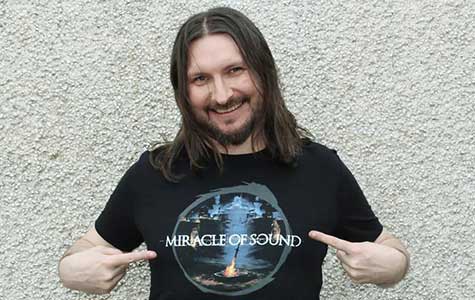
Music Tag-On: Singing & producing, + videogames, movies & TV.
Spotify Monthly Listeners: 547,096.
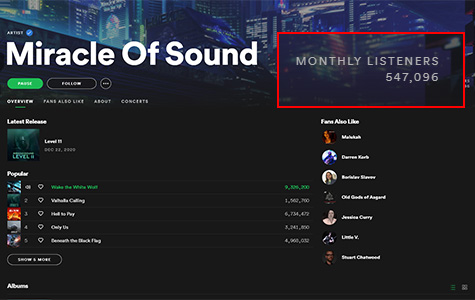
Patreon Earnings:
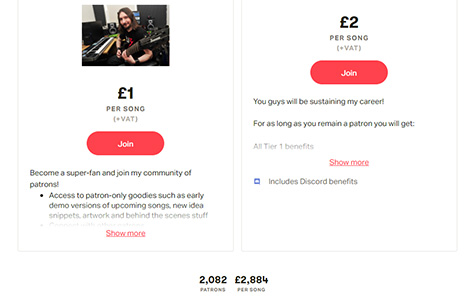
Guesstimated
30-Day Earnings: $7,838.43 from Spotify and Patreon.
The Math:
Spotify: 547,096 monthly listeners / 1,000 x 7 = $3,829.67 Spotify monthly earnings (rounded down).
Patreon: £2,884 x 1.39 (exchange rate, GBP to USD) = $4,008.76 Patreon monthly earnings).
My Thoughts
Gavin is the owner of Miracle Of Sound, a channel which features original songs which go perfectly to popular movies, computer games and TV shows.
This strategy has allowed him to feed off the popularity of existing shows & marketing, but it comes at a price.
The reason I don’t base his earnings on YouTube views is because he often uses copyrighted footage on his videos.
While it’s been great for helping his songs get out there and often go viral, it means that companies likely make claims against them and keep the ad income from some of these videos.
I assume he keeps the money from some of the videos for himself, but I won’t include it in this calculation.
On Patreon he makes a guesstimated
$4,008.76 per song as he’s released on average one song a month.
On Spotify he makes a guesstimated
$3,797.74 per month.
Musician: Better Sax

Music Tag-On: Saxophone + education + entertainment.
30 day views: 7,900,642.
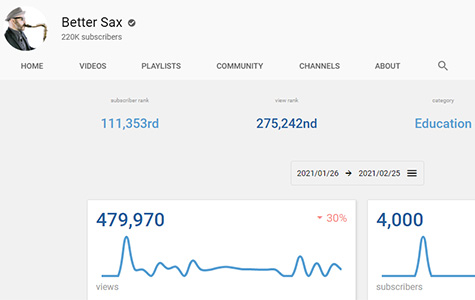
Guesstimated
30-day earnings from Youtube ads: $959.94.
The Math:
479,970 views / 1,000 x 2 = $959.94 – but see below notes for the full picture.
My Thoughts
Oh look, I’ve found a saxophonist doing something similar!
This channel is by sax teacher Jay Metcalf.
While it may not seem as profitable as the others solely based on the Youtube earnings, most likely this income is secondary to his course and product sales.
Selling courses can be lucrative, I know of music teachers & education companies who do 4, 5 or 6 figures a month.
Furthermore he sells his own brand sax, merch, and a reed adjusting tool.
I won’t guess at his overall earnings, but it’s pretty safe to say he makes a full-time income before expenses just based on his audience size.
What About Expenses?
As you may have noticed, I didn’t include any expense numbers in this article.
Quite simply, because I (unfortunately) don’t have access to these people’s bank accounts.
All of them will have incurred some kind of expenses over time, whether that’s a new sax, props for a video, video equipment or other.
So are these musicians earning less than the above numbers?
Maybe…
But maybe not.
You see, I can only guesstimate their monthly earnings using publicly available Youtube, Spotify, and Patreon numbers.
There’s no way I can find out how much they’re making from merch, gigs, digital products, sponsorships, or any of the opportunities that arise from having a sizeable following on Youtube.
That doesn’t mean the numbers in this article are worthless though.
It’s inspirational to see what kind of revenue is achievable simply by putting up Youtube videos with a spin.
You now have the tool set to look up your favorite Youtube musicians and guesstimate how much they make based on the above calculation methods.
And if others can create videos in their house and earn a full-time income via Youtube, if you approach things right, you have the potential to do the same.
Conclusion
So there you have it, a path for earning a living via sax playing, but not using a traditional path.
By doing something as simple as mixing your music with a Music Tag-On, you can create unique videos with a higher-than-average chance of going viral.
I truly feel this is one of the most underutilized opportunities for musicians today, I really hope you decide to take advantage of it.
Hi, Shaun Letang here, I’m the London based owner of Music Industry How To (MIHT).Every day MIHT helps thousands of musicians a day do more with their music career.
Now, if you like the sound of being a Youtube musician and want to learn more, you can do so here.
I also have a few guides on sax myself, like this one reviewing tenor sax mouthpieces.
So let me know your thoughts, is this a strategy you’re going to try?
I’d love to see how you get on.
Reach out to me with your channel once it’s up and if you’re using the Music Tag-On angle, I’ll give you a subscribe. :)





